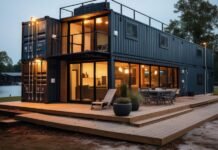Building a Sustainable Future: Lago Place and the Next Chapter in Austin’s Housing Story
As Austin, Texas, continues its rapid growth, the need for innovative housing solutions has never been more pressing. With the influx of major tech companies and an increasing number of residents, the city faces a myriad of challenges in the housing market. Younger Homes, in collaboration with Danze & Davis Architects, is taking a bold step forward with the planning of Lago Place—a 19-acre sustainable, climate-resilient community overlooking the beautiful Lake Travis, an iconic Austin attraction.
The Growing Housing Demand in Austin
Austin has experienced tremendous growth in recent years, transforming into the country’s fastest-growing city and ranking as the tenth-largest city overall. Bryan Glasshagel, senior vice president at Zonda, a housing data and consultancy firm, notes that recent job growth, fueled by tech giants like Tesla, Samsung, and Apple establishing headquarters in the area, has significantly transitioned the local housing landscape. In 2022 alone, Austin gained 13 new headquarters along with eight expansions, contributing to an extraordinary demand for housing.
However, this demand has hit a snag. According to Zonda’s data, housing starts have decreased by 25% year-over-year, while closings have increased. This imbalance is driving the median existing home price to exceed six times the median household income in Austin, making affordability a critical issue. Glasshagel suggests that potential solutions could include smaller lots and homes located further away from the city center, but an innovative approach is needed to truly address this crisis.
The Rise of Innovation and Sustainability
Austin’s reputation as a hub for innovation is well-deserved. The city attracts startups and venture capital in various industries, particularly in housing and construction. Keith Hughes, a representative from the startup Veev, emphasizes that Austin is a fertile ground for trying new ideas in homebuilding due to its unique blend of progressive values and economic growth.
Residents seeking housing proximity have to navigate a challenging market with limited affordable options. Additionally, the migration to Austin is often driven by individuals motivated by social impact and sustainability, which contrasts sharply with other areas in Texas. This desire is pushing builders to incorporate green initiatives into their projects, setting Austin apart as a leader in innovative housing initiatives.
Advancements in Construction Technology
Among the trailblazers in housing innovation is ICON, a standout in the field of 3D-printed homes. The company aims to revolutionize housing construction using its proprietary Vulcan construction system, which based on 3D printing technology majorly enhances efficiency and reduces costs. Their “House Zero,” unveiled in March 2022, illustrates the potential of additive construction in housing, while their partnership with Lennar aims to build an entire sustainable community of 100 homes outside Austin.
Another notable contributor to affordable housing solutions is Chris Krager from KRDB, a vertically integrated firm specializing in smart infill projects. By leveraging underutilized parcels of land in the city, KRDB seeks to deliver affordable to mid-range housing directly within Austin’s city limits.
Additionally, Bob’s Containers introduces a unique approach, transforming shipping containers into stylish and budget-friendly homes. Starting at $50,000, these quickly assembled residences appeal to a market that values both affordability and environmental sustainability.
Pioneering Sustainable Building Practices
Austin’s commitment to sustainability extends beyond innovative construction methods. The Austin Energy Green Building initiative, launched in 1991, established the first green residential rating system in Texas, laying the groundwork for LEED certifications across the country. These standards help ensure high-performing buildings that meet both environmental and energy efficiency goals.
Currently, initiatives like Holden Hills are emerging to blend energy-efficient building practices with sustainable living, offering renewable energy sources and environmentally-friendly materials for future residents. Founded by Jesse and Danielle Younger, Younger Homes sets its sights on building Lago Place by incorporating sustainable practices into its designs. Their project not only emphasizes the use of natural resources but also analyzes the carbon footprint of construction through tools like the Embodied Carbon in Construction Calculator (EC3).
The Community Vision at Lago Place
The Lago Place development exemplifies the shift toward accessible, sustainable living. Designed to fit seamlessly into the natural Texan hill country, the project will feature 140 net-zero-ready living units. Focused on optimizing resources, Lago Place aims to marry modern construction techniques with the preservation of natural landscapes, thereby enhancing residents’ quality of life.
Through such projects, local developers like the Youngers emphasize the importance of educating homebuyers about the benefits of sustainable living and efficient designs. They advocate for more control over the building process to elevate affordability and accessibility in the market.
Future Challenges and Opportunities
While Austin’s housing market is vibrant with new ideas and movements toward sustainability, it faces significant infrastructure and transportation challenges stemming from its exponential growth. The city is confronted with the task of managing these dynamics while ensuring it remains a desirable destination for newcomers.
Innovative endeavors, such as Elon Musk’s establishment of Snailbrook for his company’s employees, demonstrate that alternative housing solutions can arise from the intersections of corporate influence and community needs.
In pursuit of effective housing solutions, Austin stands at a crossroads, facing the intricate balance of growth, sustainability, and affordability. Lago Place, backed by Younger Homes and its eco-centric vision, may well become a model for developers striving to meet the needs of a rapidly changing city. As Austin continues to innovate, the future of housing in this burgeoning metropolis looks promising—if not yet fully realized.














